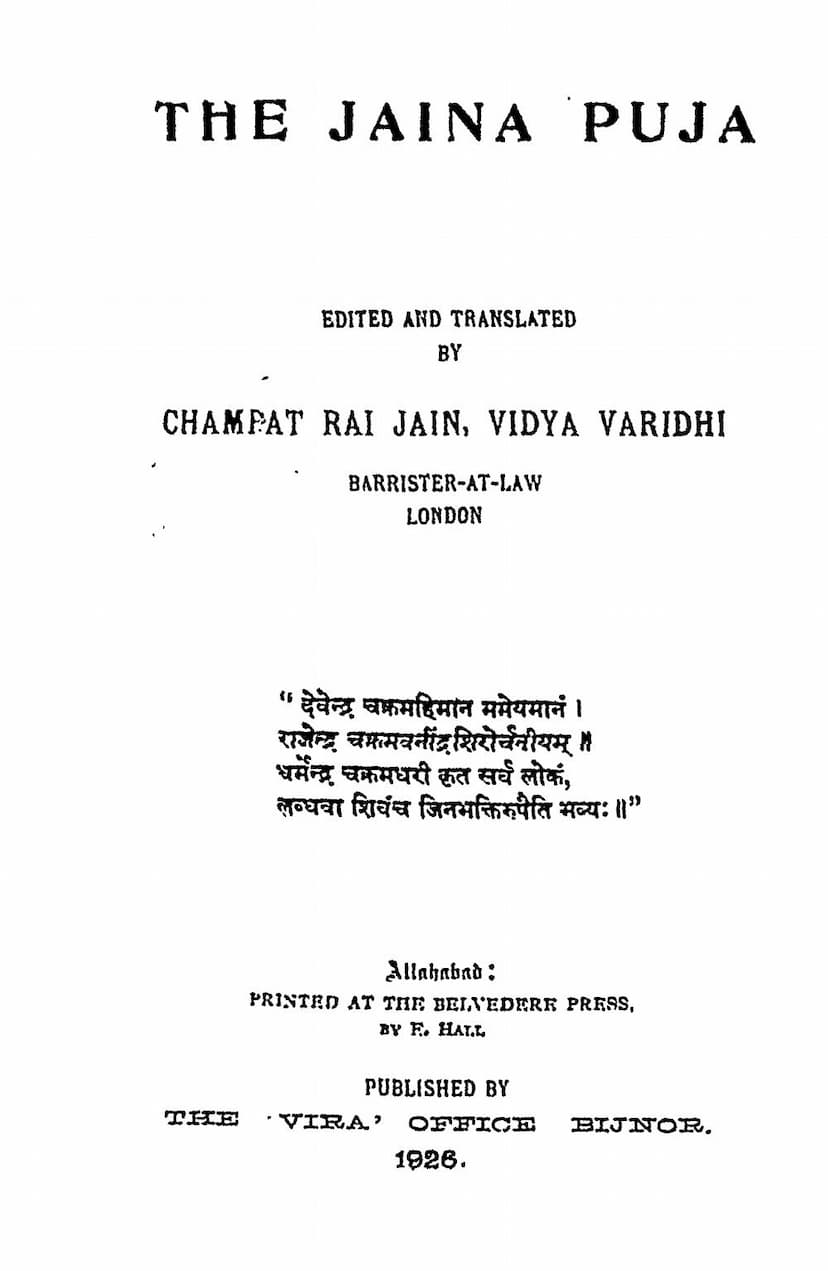Jaina Puja
Added to library: September 2, 2025

Summary
Here's a comprehensive summary of the Jain text "Jaina Puja" by Champat Rai Jain, based on the provided pages:
Core Purpose and Philosophy of Jaina Puja:
The Foreword (Page 7) is crucial in understanding the foundational philosophy behind Jaina Puja. It strongly emphasizes that Jaina worship is not about pleasing or propitiating deities to gain favors. Jainism is an iconoclastic faith, rejecting idolatry in favor of ideal-atry. The Jinas (Tirthamkaras) are considered liberated souls who have attained the highest ideal of perfection. The purpose of puja is for the devotee to adore the attributes of Divinity and to emulate and imitate these perfected beings in their own lives.
Key Aspects of Jaina Puja:
- No Demanding Deities: Jain Gods are never displeased and have no boons to grant. In fact, they advocate renunciation of worldly pleasures, which are often the subjects of devotees' prayers. They do not require offerings of food or scents.
- Symbolic Offerings: Offerings made during puja are not literal gifts to the deity. Instead, they represent the devotee's mental renunciation of those things or have symbolic significance. For example, rice symbolizes the "indestructible seat."
- Ideal-atry over Idolatry: The focus is on the ideal of perfection embodied by the Jinas, not on worshipping idols in a superstitious manner.
- The Three Jewels (Triratna): The puja is directed towards the Deity (Deva), the Scripture (Shastra), and the Guru (Saint), which represent Right Faith, Right Knowledge, and Right Conduct, respectively.
- Two Aspects of Ritual:
- Dravya Puja (Material Puja): This involves the external ritualistic acts and the offering of various material substances like water, sandalwood, rice, flowers, etc.
- Bhava Puja (Mental Puja): This is the internal reverence, contemplation, and devotion that should precede, accompany, and follow the external ritual. This is considered the more valuable aspect in terms of merit.
- Purpose of Material Puja: While Bhava Puja is superior, Dravya Puja is highly beneficial as it helps concentrate the mind, preventing it from wandering and facilitating Dharma Dhyana (meritorious meditation).
The Ritual Process (as described on pages 11-13 and following):
The book outlines a specific ritual process involving eight main articles:
- Sterilized Water: For purification.
- Sandal-wood or Saffron Paste: Symbolic of purity and cooling.
- Rice (Akshata): Symbolizing the "indestructible seat."
- Flowers (or Colored Rice): Representing devotion and beauty.
- Sweets (or Coconut Pieces): Symbolizing the sweetness of spiritual attainment.
- Camphor: For light, symbolizing spiritual illumination.
- Incense: For fragrance, symbolizing the eradication of karmic odors.
- Fruits (or Almonds): Symbolizing the fruits of spiritual endeavor.
The combination of all eight articles is called Arghya.
Key Stages of the Puja:
- Preparation: Articles are prepared, and a plate is set up with a Swastika mark in the center, representing the three jewels.
- Invocation (Mantram): Invocation mantras are recited to invite the presence of the Deity, Scripture, and Guru.
- Prakshala (Washing): This is a compulsory step, symbolizing purification. Water is poured over the image or footprints of the Jina. If no image is present, water is poured into a bowl.
- Offerings (Mantram and Chhanda): Each of the eight articles is offered with specific mantras and accompanying verses (Chhanda and Doha) that explain the symbolic meaning and the virtues of the Jinas.
- Water: For cleansing and destroying the cycle of birth, old age, and death.
- Sandalwood/Saffron: For cooling the heat of worldly existence and destroying the cycle of rebirths.
- Rice: For attaining the "indestructible status" and as a symbol of unbroken purity.
- Flowers: For escaping the pain of repeated births and deaths.
- Sweets: For destroying the "pain of hunger" (kashaya or internal desires).
- Light (Camphor): For destroying the "darkness of delusion" and illuminating the soul.
- Incense: For the destruction of the "eight kinds of karmas."
- Fruit: For the attainment of "moksha phala" (the fruit of liberation).
- Arghya: All eight articles are mixed and offered together, symbolizing a complete offering for the attainment of the "indestructible status."
- Maha-Arghya: Whatever is left of the eight articles is offered at the end.
- Shanti Patha: Recitation of prayers for peace and well-being for oneself, the community, and the world.
- Visarjana Patha: A concluding prayer asking for forgiveness for any shortcomings in the ritual and for the deities to return to their rightful places.
- Adoration (Stotra): Verses praising specific Tirthamkaras, highlighting their virtues and the benefits of worshipping them.
- Conclusion: Final prayers and affirmations of devotion.
Specific Practices Mentioned:
- Saffron vs. Sandalwood: Saffron is often preferred as it's considered purer.
- Flowers: Fresh flowers are discouraged due to the principle of ahimsa (non-violence), and colored rice is used as a substitute.
- Digambara vs. Svetambara: The text notes differences in practices between these sects, particularly regarding the use of ornaments and clothes for images. The Tera-panthi Digambaras avoid applying saffron or decorating images with flowers, considering the divine form to be Nirgrantha (nude) and unadorned.
Overall Message:
"Jaina Puja" presents a detailed guide to a fundamental Jain ritual, emphasizing its philosophical underpinnings. It teaches that true worship is an internal process of emulation and self-improvement, facilitated by external actions that serve to focus the mind and cultivate virtuous qualities. The ritual is designed to help the devotee progress spiritually towards liberation by contemplating the perfections of the Jinas and applying their teachings in daily life.